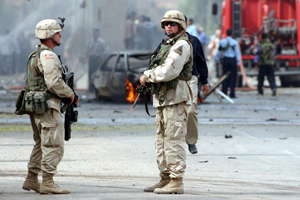By Jason Kelly
Courtesy Of "The University Of Chicago Magazine"

Common detonator: The U.S. invasion of Iraq ignited a surge in suicide terrorism.
Until the 2003 invasion of Iraq, there had never been a suicide terrorist attack in the country. The first occurred days after American troops arrived, and the number increased to 256 in 2007 before declining.
In his book Cutting the Fuse: The Explosion of Global Suicide Terrorism and How to Stop It (University of Chicago Press, 2010), Chicago political scientist Robert A. Pape, PhD’88, and coauthor James K. Feldman argue that foreign military occupation, not religious extremism, fueled that rise. At an October 12 conference in Washington, Pape outlined data from his research into 30 years of suicide attacks worldwide.
“What over 95 percent of all suicide attacks since 1980 have had in common is not religion but a specific strategic objective: to compel a democratic state to withdraw combat forces from territory the terrorists consider their homeland or prize greatly.”
As director of the Chicago Project on Security and Terrorism (CPOST), Pape has compiled a database of more than 2,000 incidents. To root out the common causes, he’s investigated recordings that bombers left behind, information about their religious affiliations and socioeconomic status, and other personal details.
From 1980 to 2003, suicide terrorism was relatively rare, and the threat to American citizens was minimal: fewer than 15 percent of the 343 such attacks around the world were directed against U.S. interests. Yet from 2004 to 2009, there were 1,833 suicide strikes—92 percent aimed at American targets.
Before that increase, of course, came September 11, 2001, which brought the effects of suicide terrorism into sharp relief in the United States. Less than a decade earlier, Islamic terrorists killed six people in a World Trade Center bombing. Yet the February 26, 1993, attack “did not turn the American government, our military, and much of the country upside down to prevent it from happening again,” Pape and Feldman write in Cutting the Fuse.
The difference, the authors argue, was suicide terrorism, which inflicts disproportionate horror—19 perpetrators killed thousands of civilians, which was possible in large part because they were willing to sacrifice their own lives. As Pape puts it, “Suicide terrorists are the ultimate smart bomb.” Such attacks accounted for only three percent of global terrorism between 1980 and 2001, but caused 70 percent of the deaths.
Seldom have the attackers been seeking religious martyrdom. In the 24 years before the Iraq invasion, the secular Tamil Tigers committed the most suicide attacks of any terrorist organization worldwide—committing 78 against Sri Lanka between 1987 and 2001.
Even among fundamentalist groups, repelling foreign military occupation was the underlying motivation.
From Lebanon in the 1980s—the first suicide attacks since World War II kamikazes—to Iraq and Afghanistan now, the presence of foreign troops from democratic countries, which are considered “vulnerable to coercive punishment,” has coincided with a rise in suicide terrorism.
Even in Iraq, where a 2008 decline in attacks overlapped with an increase in U.S. troops, Pape’s findings still hold: despite the “surge,” he points out, the net result was a smaller foreign military presence because coalition troops were leaving at a higher rate than U.S. forces were arriving.
Pape and Feldman found similar circumstances in Afghanistan. There were fewer than 15 suicide attacks in the country from 2003 to 2005, but the number spiked to 87 in 2006 and 128 the following year. “It stays high,” Pape said. “Why?” From 2001 onward, international forces arrived in increasing numbers in Kabul, then in the country’s north and west. But they did not spread to the Pashtun homeland in southern Afghanistan until October 2006. After that, Pashtun suicide terrorism ignited.
It’s a predictable pattern: Pape and Feldman identify these correlations in the eight major suicide terror campaigns dating to the early 1980s. Including an October 23, 1983, suicide truck bomb that killed 241 U.S. Marines, there were 30 attacks in occupied Lebanon between 1982 and 1986.
At the time, Hezbollah’s Shia Muslim attackers led many people to believe religious fundamentalism was the organization’s driving motivation. Cutting the Fuse explains that Hezbollah did not exist before Israel’s June 1982 invasion. By that July, it had formed.
In the four years that followed, those 30 attacks were “all directly or tacitly coordinated by Hezbollah.”
As foreign troops left the country—first the United States, then France, then Israel—the number of suicide attacks declined. “Since Israel’s military withdrawal in 2000,” Pape said, “there has not been a single Lebanese suicide attack.”
So, he asked rhetorically, paraphrasing a question from former Defense Secretary Donald Rumsfeld:
Were more terrorists being produced than the United States was capturing or killing? Pape presents his research as an emphatic yes: “Foreign occupation is the trigger for suicide terrorism,” he said, “much like smoking is the trigger for lung cancer.”




No comments:
Post a Comment